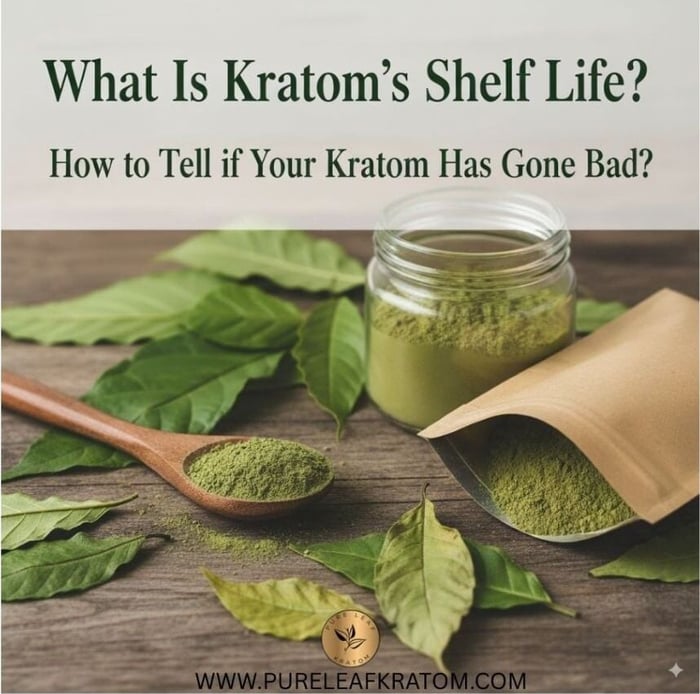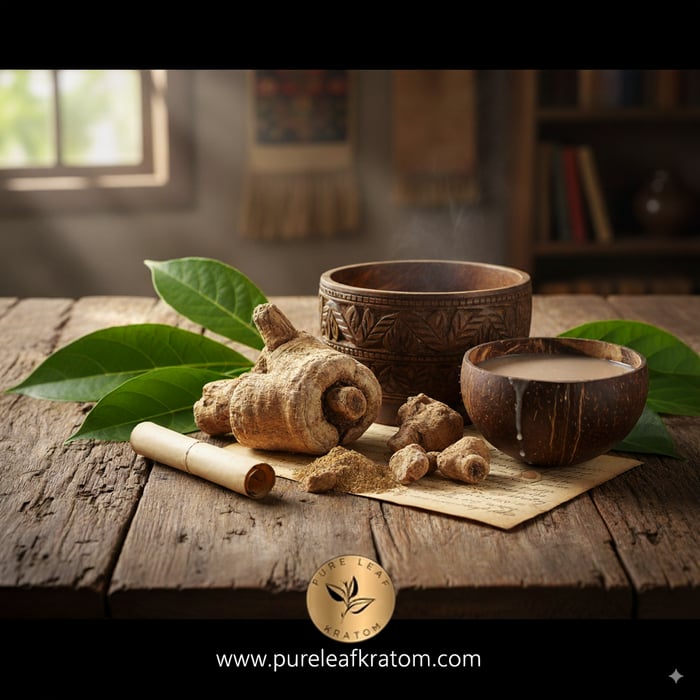
What Is Kratom’s Shelf Life? How to Tell if Your Kratom Has Gone Bad
Table of Contents
- How Long Does Kratom Last?
- What Affects Kratom’s Shelf Life?
- How to Store Kratom to Keep It Fresh Longer
- Sign's Your Kratom May Have Gone Bad
- How to Rotate Your Stash (FIFO Method)
- When It’s Time to Replace Old Kratom
- Final Thoughts: Keep It Fresh, Keep It Enjoyable
- Shop Fresh Batches at Pure Leaf Kratom
- FAQs
What Is Kratom’s Shelf Life? How to Tell if Your Kratom Has Gone Bad
When you order a new batch of kratom, there’s nothing quite like the moment you open it up. The rich, earthy aroma greets you as soon as the seal breaks, and the fine, vibrant powder inside instantly reminds you why you love exploring this botanical. That first scoop always feels special a fresh batch carries with it the care and craftsmanship that went into harvesting, drying, and preparing each leaf before it ever reached your shelf.
But as time passes, even the freshest kratom begins to change. Like all natural botanicals, kratom doesn’t stay at its peak forever. It won’t spoil in the way fresh produce does, but its color can fade, its natural aroma can weaken, and its overall quality can gradually decline. If left sitting in the wrong conditions, it can even develop issues like moisture buildup or clumping, which are clear signs that it’s no longer at its best.
This raises an important question for anyone who enjoys kratom regularly or likes to stock up: how long does kratom actually last, and how can you tell when it’s past its prime? Knowing the answer can make the difference between a consistently enjoyable experience and an underwhelming one.
Just like herbs, teas, and other dried botanicals, kratom has a natural shelf life and understanding that shelf life is key to making the most of every batch. While it doesn’t expire on a specific date, it can slowly lose its freshness if it isn’t stored properly or if it sits unused for too long.
Whether you’re someone who rotates between multiple strains or someone who prefers to stick to one trusted favorite, learning how to keep your kratom fresh will help preserve its quality, appearance, and aroma.
In this guide, we’ll break down everything you need to know about how long kratom lasts, what can shorten its shelf life, how to store it correctly, and the clear signs it might be time to replace an old batch.
How Long Does Kratom Last?
Kratom is made from carefully harvested, dried, and finely ground leaves and like other dried plant products, it’s naturally stable for quite some time. When stored in the right conditions, kratom can maintain its quality, color, and aroma for about one to two years from the date it’s packaged. This relatively long shelf life is one of the reasons many enthusiasts feel comfortable buying it in bulk or keeping a variety of strains on hand to rotate through.
However, this general timeframe isn’t a hard expiration date. Kratom doesn’t suddenly go bad overnight. Instead, its decline is gradual and subtle, with small changes happening over time. As the months pass, factors like air exposure, temperature shifts, moisture, and light can slowly break down the delicate plant material. These elements don’t just affect how kratom looks they can also dull its rich, earthy aroma and leave it feeling flat or lifeless compared to when you first opened the package.
Eventually, kratom that has aged beyond its ideal window may appear pale or dusty, and its scent may be faint or nonexistent. While this doesn’t make it unsafe, it does mean the product has lost the freshness and quality that make it so appealing.
If you want your kratom to stay as close to its original state as possible, proper storage is essential. By protecting it from the environmental elements that cause natural breakdown, you can dramatically extend its shelf life and keep it feeling as vibrant as the day you bought it.
What Affects Kratom’s Shelf Life?
Several factors can cause kratom to lose its freshness faster than it should, and understanding them is the first step in preserving your stash. While kratom is naturally stable, it’s still a plant-based product which means it can be sensitive to its surroundings. Even small amounts of exposure to the wrong conditions over time can slowly degrade its appearance, aroma, and overall quality.
Here are the most common culprits behind premature aging:
Air exposure:
Every time you open your container, air rushes in and begins interacting with the plant material inside. Oxygen exposure is one of the main reasons kratom slowly loses its natural aroma and color over time. While opening your container briefly won’t ruin it, repeated exposure can add up, especially if you keep your kratom for months.
Moisture:
Humidity is one of the biggest threats to kratom’s shelf life. When moisture gets into your container, it can cause the powder to clump together and, in worse cases, encourage mold growth. Even small amounts of condensation or damp air can be enough to compromise your batch, which is why keeping kratom dry is essential.
Heat:
High temperatures can speed up the natural breakdown of plant compounds. Storing kratom near stoves, heaters, or other warm spots can shorten its shelf life without you even realizing it. Cooler environments help preserve the leaf material for much longer.
Light:
Direct sunlight doesn’t just warm the container it can actually break down the leaf material over time. Constant exposure to light can cause your kratom to fade and lose its vibrant color, which often goes hand in hand with a loss of freshness.
Frequent opening and resealing:
Even if you store kratom properly, opening the same bag multiple times a day speeds up its exposure to air, light, and moisture. The more often it’s opened, the quicker it ages. If you use kratom often, it’s better to portion out smaller amounts into a secondary container and leave the rest sealed tightly.
Packaging quality:
Thin or poorly sealed packaging doesn’t offer much protection from the elements. Bags that aren’t airtight allow in small amounts of air or moisture, which gradually reduce freshness. Thick, resealable packaging or airtight containers are much more effective at keeping your kratom safe from environmental damage.
The good news is that all of these factors are completely manageable. By being mindful about how and where you store your kratom, you can slow down the natural aging process and help your batches stay as fresh and vibrant as the day they arrived.
How to Store Kratom to Keep It Fresh Longer
The key to giving kratom a long shelf life is protecting it from the main elements that cause it to break down: air, moisture, heat, and light. Even though kratom is a dried botanical and naturally stable, it can still lose its vibrancy if it’s not stored with care. Thankfully, it only takes a few simple habits to keep your supply in top condition.
Whether you prefer kratom in powder, capsule, shot, or tablet form, these steps will help you safeguard your stash and preserve its freshness for as long as possible.
1. Use airtight containers
Once you open your kratom, the packaging it came in may not always offer the best long-term protection. Transferring it to airtight jars, tins, or resealable mylar bags can create a much stronger barrier against air and moisture.
Mason jars and dark glass jars are excellent options, especially if they have rubber seals.
Resealable mylar bags are lightweight and block out both light and air, making them a popular choice for larger batches.
If you store multiple strains or product types, clearly label each container with its strain name, batch number, or the date it was opened so you can easily track freshness.
2. Keep it in a cool, dark place
Heat and sunlight are two of the biggest enemies of freshness. Always store kratom in a place that stays consistently cool and shaded.
A kitchen pantry, a dresser drawer, or a cabinet are all great options.
Avoid placing kratom near stoves, ovens, windows, or electronics that produce heat, as temperature fluctuations can accelerate breakdown.
3. Keep it dry
Moisture is one of the fastest ways to ruin a good batch of kratom. Even small amounts of humidity can cause the powder to clump together and, in some cases, encourage mold growth.
Avoid storing kratom in bathrooms, kitchens, or other humid environments.
For extra protection, you can place a food-safe silica gel packet inside your container to absorb excess moisture. Just make sure the packet doesn’t touch the kratom directly place it above the powder or secure it to the lid.
4. Minimize exposure
Every time you open your container, a little air and light sneak in. Over time, this adds up.
Try to open containers only when needed, and reseal them as soon as you’re done.
Scoop out what you need quickly instead of letting the bag sit open on the counter.
If you use kratom often, consider portioning out small daily-use amounts in a secondary container and keeping the main supply sealed tight.
By following these simple practices, you can slow down the natural aging process and keep your kratom fresh, vibrant, and aromatic for months or even years. Proper storage not only protects your investment but also ensures that every scoop feels as good as the very first one.
Sign's Your Kratom May Have Gone Bad
Kratom doesn’t spoil in the same way that milk or fresh produce does, but it can still lose its quality or become compromised over time. Exposure to air, moisture, or heat can gradually break down its natural properties, while improper storage can introduce contamination and shorten its shelf life.
Recognizing the warning signs of stale or spoiled kratom helps you avoid wasting time with a batch that’s past its prime and make better decisions about what stays on your shelf.
Here’s what to look for:
• Faded or dull color
Fresh kratom usually has a rich, vibrant hue—whether it’s green, red, or white. If your kratom looks noticeably pale, dusty, or washed out, it’s often a sign that its freshness has faded. This typically happens when it’s been exposed to too much light or air.
• Weak or flat aroma
Fresh batches carry a distinct earthy botanical scent. When kratom has gone stale, that scent becomes faint, flat, or almost nonexistent. If it smells bland, it has likely lost much of its original character.
• Clumping or damp texture
Kratom should have a dry, fine, powdery texture. If it feels clumpy, sticky, or damp, moisture has probably gotten inside the container. This can accelerate spoilage and even encourage mold growth.
• Musty, sour, or unusual odor
A clear red flag is any smell that seems off, sour, musty, or moldy. If your kratom gives off an unfamiliar odor instead of its usual earthy scent, it’s best to discard it.
• Visible mold or discoloration
White fuzz, dark patches, or irregular spotting are all clear indicators of mold or contamination. Any unusual or uneven coloring means it’s safest to throw it out and not take chances.
How to Rotate Your Stash (FIFO Method)
If you like keeping multiple batches or varieties of kratom on hand, it’s important to rotate them regularly so nothing sits forgotten at the back of your shelf. Even when stored properly, kratom gradually loses freshness over time, and older batches can start to fade in aroma, color, and overall quality. A simple rotation system ensures that every batch you use is fresh, vibrant, and enjoyable.
One of the easiest ways to manage multiple batches is the FIFO method “First In, First Out.” This approach is commonly used in food and retail industries to maintain freshness and prevent waste, and it works perfectly for kratom. Here’s how to implement it:
Label each batch clearly: Mark the purchase or open date on every container. If you have several strains, include the strain name as well. Clear labeling makes it easy to see which batch should be used first.
Place older batches in front: When storing multiple containers, make sure the oldest batches are in front or on top so they are used before newer ones. This simple adjustment ensures you’re always consuming kratom at its peak.
Avoid mixing old and new batches: Combining different batches in the same container can accelerate aging for the fresher product. Keep each batch in its original container or in a dedicated, airtight jar.
Restock in small amounts: If you don’t go through kratom quickly, consider buying smaller quantities more often rather than a large bulk order. Smaller amounts are easier to rotate and less likely to sit unused for long periods.
Check periodically: Even with proper rotation, it’s a good idea to inspect your batches regularly for changes in color, aroma, or texture. This ensures that nothing goes unnoticed and that your kratom remains enjoyable.
By following these steps, you can maintain an organized stash and maximize the freshness of every batch. A simple rotation system is a small effort that pays off with better quality, more consistent experiences, and less wasted product.
When It’s Time to Replace Old Kratom
Even perfectly stored kratom won’t remain at peak quality indefinitely. Over time, natural changes occur in the leaves and powder that can affect color, aroma, and texture. If you’re ever unsure how old your stash is, or if you notice that it no longer looks or smells like it did when you first opened it, it’s a good idea to consider replacing it. Using fresh kratom not only ensures the best experience but also reflects the care and quality standards you expect from a reputable brand, while helping you maintain a reliable shelf of products you can trust.
Here’s a detailed checklist to help you determine whether it’s time to replace a batch:
Has it been over two years since you bought it?
While kratom can last up to two years when stored properly, anything older may have started to lose its vibrancy, aroma, and overall quality. Even if it looks okay on the surface, subtle degradation can affect the overall experience and signal that it has reached the end of its shelf life.
Has it lost its natural color or scent?
Fresh kratom usually has a rich, earthy color and a noticeable botanical aroma. If it appears pale, washed out, or lacks its usual scent, it’s likely past its prime. Color and aroma are easy indicators of freshness, so paying attention to them can save you from using an inferior batch.
Is the texture clumpy, damp, or unusual?
Moisture is one of the main culprits in kratom deterioration. If the powder has developed clumps, feels sticky, or seems uneven in texture, it may have been exposed to humidity or improper storage conditions. This can impact both the quality and safety of the product.
Does it have mold or unusual spots?
Any white fuzz, dark spots, or other irregular discolorations are clear signs that the batch should be discarded. Mold and contamination are risks that you don’t want to take, and even small visual changes should be treated seriously.
If you answered “yes” to any of these questions, it’s safest to toss the old batch and start fresh. Fresh kratom doesn’t just look and smell better it also guarantees the vibrant quality and consistency that make the experience more enjoyable.
Remember, replacing older kratom isn’t just about avoiding diminished quality it’s also about maintaining a collection that you can rely on. By regularly checking your stash and rotating older batches out for fresh ones, you ensure that every scoop delivers the aroma, color, and consistency you expect. Proper care and attention help you get the most out of your kratom, so you can enjoy it with confidence every time.
Final Thoughts: Keep It Fresh, Keep It Enjoyable
Kratom can remain fresh and enjoyable for a long time, but maintaining its quality requires a little care and attention. Like any dried botanical, it’s sensitive to the elements particularly air, moisture, heat, and light and these factors can slowly diminish its color, aroma, and texture over time. With proper storage, however, you can preserve a batch for up to two years or even longer, ensuring that every scoop delivers the same rich experience as when it was first packaged and helping it maintain a long shelf life.
A key part of keeping kratom fresh is simply being mindful of its appearance and scent. Bright, vibrant colors are a reliable indicator that the leaves are still at their peak. Similarly, a strong, earthy aroma is a good sign that the natural qualities of the kratom remain intact. The texture is also important it should remain fine and powdery, free from clumps or damp spots. Checking these three factors regularly can give you a clear sense of whether your kratom is still at its best.
If you ever feel unsure about an older batch, it’s safer to replace it with a fresh one. Even when stored carefully, kratom can gradually lose some of its vibrancy, and there’s no way to restore that original freshness once it’s gone. Starting fresh ensures that every experience is as satisfying as possible.
Another way to maintain freshness is to rotate your stash. If you keep multiple batches or strains on hand, use the FIFO method (First In, First Out). This ensures you use the older batches first and reduce the chances of letting a batch sit too long on your shelf. Portioning out smaller amounts into secondary containers for daily use also helps limit exposure to air and moisture, preserving the rest of your supply.
Finally, remember that freshness isn’t just about aesthetics it’s about the overall experience of using kratom. There’s nothing quite like opening a brand new bag and breathing in that rich, earthy scent for the first time. Each batch is the result of careful harvesting, drying, and preparation, and taking the time to store it properly means you can enjoy those qualities for months or even years.
By following these simple yet effective steps keeping kratom cool, dry, airtight, and out of direct light, monitoring its color, aroma, and texture, and rotating your stash wisely you’ll ensure that your kratom remains vibrant, aromatic, and enjoyable every time you use it. Proper care allows you to get the most out of every batch, preserving both its quality and the pleasure of the experience.
Shop Fresh Batches at Pure Leaf Kratom
At Pure Leaf Kratom, every product is carefully packaged and batch-labeled to help you track freshness with confidence. Whether you’re restocking a favorite or exploring something new, you can shop knowing you’re getting fresh, high-quality kratom every time.
FAQs
Q: How long does kratom last?
A: When stored properly, kratom can stay fresh for about one to two years from its packaging date. While it doesn’t suddenly expire, its quality gradually declines over time.
Q: Does kratom go bad or expire?
A: Kratom doesn’t spoil like perishable foods, but it can lose its color, aroma, and overall quality. It may also develop mold or clumps if exposed to moisture.
Q: What are the signs that my kratom has gone bad?
A: Watch out for:
Faded or dull color
Weak or flat aroma
Clumping or damp texture
Musty, sour, or unusual smell
Visible mold or dark spots
If you notice any of these, it’s safest to discard it.
Q: What shortens kratom’s shelf life?
A: The main culprits are air, moisture, heat, light, frequent opening, and poor packaging. These elements slowly degrade the plant material and reduce freshness.
Q: How should I store kratom to make it last longer?
A: Follow these best practices:
Use airtight containers (jars, tins, or mylar bags)
Keep it in a cool, dark place away from sunlight and heat
Keep it dry and avoid humid environments
Limit how often you open the container
Label batches with purchase/open dates
Q: Can I store different batches together?
A: It’s better to avoid mixing batches. Combining older and newer kratom can speed up the aging of the fresh batch. Keep them in separate, labeled containers.
Q: How can I keep track of freshness if I buy multiple batches?
A: Use the FIFO method (First In, First Out):
Label containers with the date you bought or opened them
Place older batches in front so they get used first
Restock in small amounts to prevent excess aging
Q: When should I replace my kratom?
A: Replace your kratom if:
It’s over two years old
It has lost its color or aroma
It feels clumpy, damp, or sticky
It shows mold or odd discoloration
Fresh kratom is always more vibrant, aromatic, and enjoyable.
Q: What’s the biggest key to long-lasting kratom?
A: Keep it cool, dry, airtight, and out of light and regularly check for changes in color, aroma, or texture. Proper storage preserves freshness for months or even years
Q: What’s the secret to keeping kratom at its best?
A: Seal it tight, keep it cool and dry, protect it from light, and rotate it regularly. A little care goes a long way toward preserving its rich aroma and vibrant appearance.




